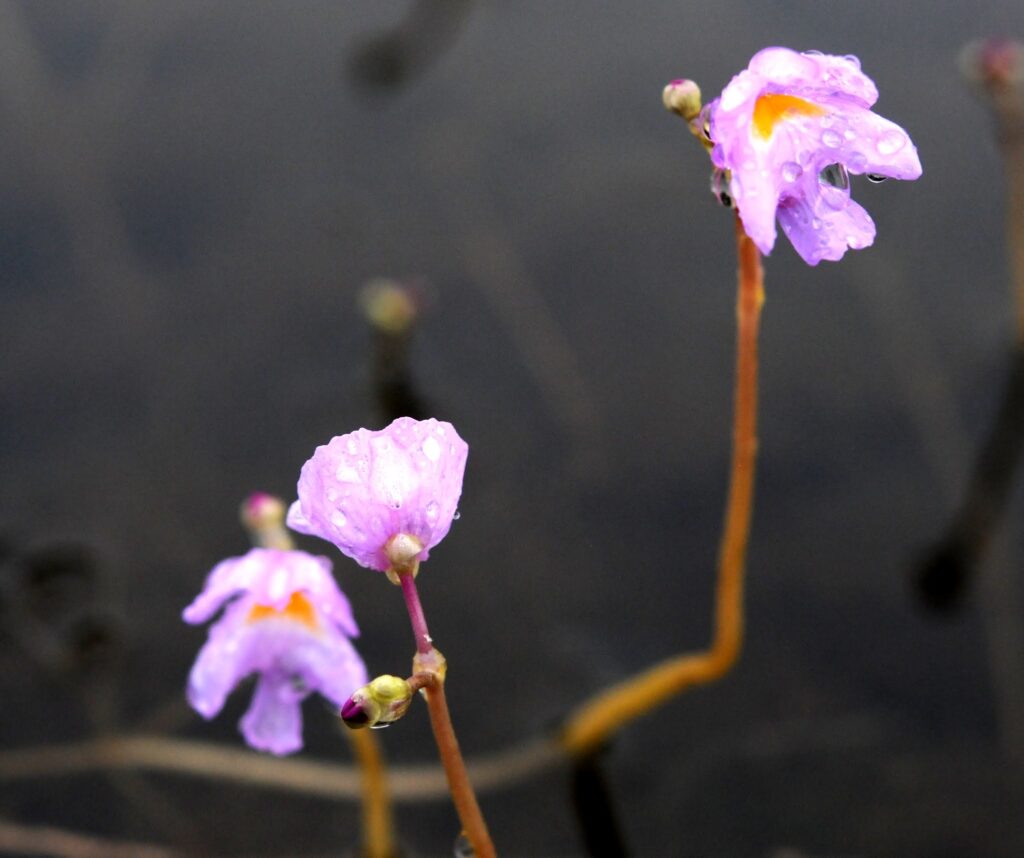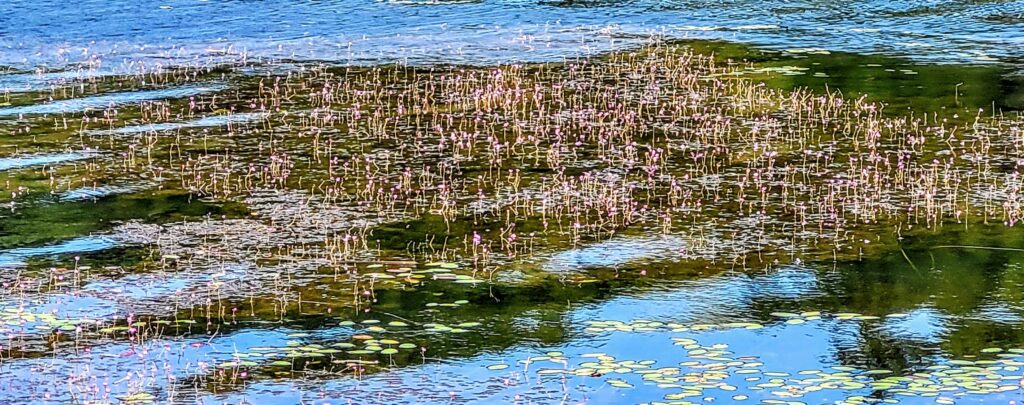No environmental topic brings France and I more questions that aquatic plants.
There is a reason for that. There are all kinds of plants in our lakes and they move constantly. They show up one year, disappear the next and are replaced by another species. It is a very dynamic environment.
Take Easter Purple Bladderwort. It is is an aquatic carnivorous plant found in healthy lakes throughout Easter North America, from Quebec and Ontario to Florida and Texas. This indigeneous plant is small and showy lavender flowers bloom in late summer in our area. This highly specialized indigeneous plant feeds on insects and other small microorganisms caught in its bladder-like trap.

In Dunany, it can be found at the east end of Black Lake, sometime called Frenchy’s Bay. Some years it expands considerable as it does this summer. Other times, as in 2020 and in 2021, it mysteriously contracts and occupies only a small fraction of the surface of the bay.
We know that Bladderworts rely on water currents, animals, or human activities for seed and fragment dispersal. For years, we have been wondering why is it that plant’s coverage in the bay varies so much from year to year. What are the drivers of this phenomenon?
But first a bit of history. In mid-August of 1981, a team from the Fish and Wildlife Technology Program of Vanier College did a plant and animal life inventory in Boyd and Black lakes. I was given a copy of the report published the following year. Interestingly, the is no mention of purple bladderwort.

Purple bladderwort’s growth cycle is a highly specialized adaptation to its aquatic environment, allowing it to survive in challenging conditions and successfully reproduce in nutrient-poor habitats.
We do have data showing that Black lake is healthy and, consequently, nutrient-poor.
My research leads me to the following conclusion:
- Climate is the main driver of the changes we have observed, especially temperature and humidity.
- Warmer water combined with high humidity, especially heavy rainfalls, are driving the expansion of the plant.
- Evidently, the opposite is true: colder water combined with drought will have the opposite effect.
A few years ago, I consulted with one of Québec’s most recognized lake specialist, Richard Carignan PhD. who visited Black lake and even produced this 2.5 minutes under water video of the world below the plants in the bay which you can view here. Look for utriculaire pourpre bottom left.
His advice. Do nothing. You can easily do more harm than good
There are other lakes in Quebec where purple bladderwort is found. Lakes Edouard, Traverse, aux Jésuites, du Chevreuil, Galipault, St-Pierre, des Deux Montagnes to name a few, and many in provincial parks lakes as well as the Outaouais region. However, there is no comprehensive list and specific information as we have about Black Lake.
Ultimately, temperature, precipitation, especially heavy ones, and seasonal changes impact the growth cycle of bladderworts. Climate change, which brings us extreme events, may have some surprises in store for us.
For better or for worse, we must continuously adapt.

I can confirm seeing Purple Bladderwort along the shallow north edge of the bay of Black lake in 2014. Not as prolific as this year’s crop. It is a rootless carnivorous plant, that lives in suspension, and only in shallow water. It’s success is clearly related to increased water temperature, as we saw in 2014 and 2024, and possibly aided by increased organic matter when there are heavy warm rains. The bathymetric map on this page shows an extensive area of shallow water along the north shore the bay.
I researched this plant and what, if anyrhing could be done about, when it appeared to flourish in 2014. Prior to the plants flowering phase, it can be removed without the fear of it spreading and and colonizing other shallow areas. However it should not removed once flowers appear.
Very interesting Jacques. Thank you for the information!
Very interesting Jacques. Thank you for the information!
Thank you for this!